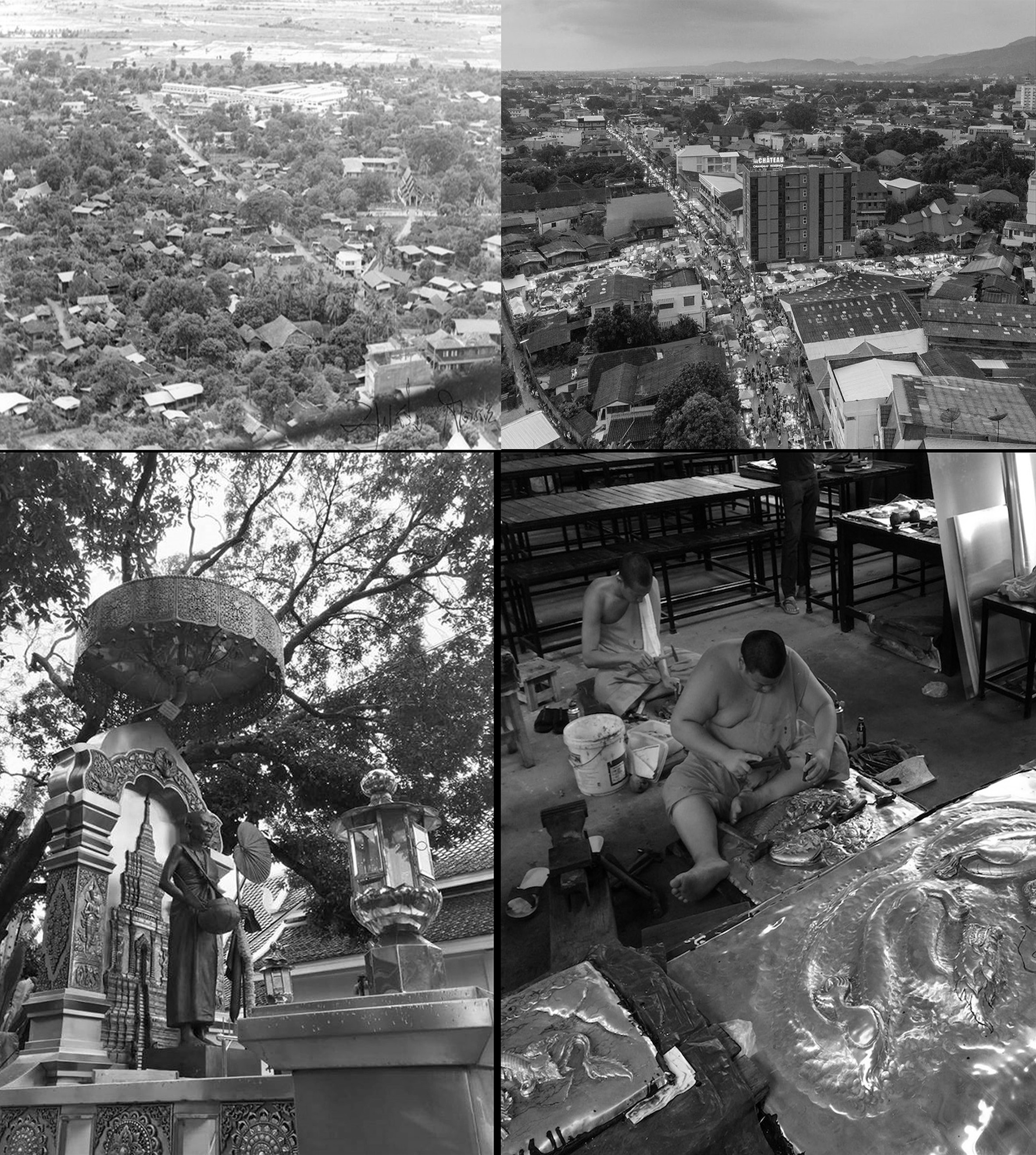The study of neighborhood and the sustaining network of local knowledge: the case of “Wua-Lai” silver craft neighborhood, Chiang Mai province
Main Article Content
Abstract
This research is an action-research within Wua-Lai neighborhood, one of the significant old areas of Chiang Mai old town. The areas are artisan-family bases specializing in silver craft skills to serve the city. The research examines the subject of “Neighborhood” focusing on two neighbors, namely Wat Sri-Suphan and Wat Muen-Sarn. The neighborhoods have their special skills inherited from “Tai-Shan” silversmith village who immigrated to Chiang Mai by King Kawila’s strategy of rebuilding the city of Chiang Mai with his concept of “collecting people to fill the city”. At the present, Wua-Lai has gone through significant socio-economic transformation and urban change that have caused the response to the crisis by developing the temple-oriented neighborhood projects, aiming at reviving the silver craft productions, preserving and transmitting the craft skills as key sources for local organizations and knowledge sustaining approaches. This has created a So-called “Neighborhood Development Model”. The research raises questions about how the neighborhood constructed the network relationships of the silversmith knowledge sharing and maintaining their craftmanship upon the existence of neighborhood’s role of silversmith kills and products making process, which are the main area’s characteristics and heritage with Buddhist temples as a center of the neighborhoods’ life and social relation within the area. There are two consequent findings. The first is about the grassroot movements that are collaborated by developing local projects and these have formed local organizations. The second deals with the interconnection between neighborhood and contemporary city of Chiang Mai over tourism development which had led to the revival of local craft productions and heritage conservation, also sustaining the local silversmith knowledge in the future.
Article Details

This work is licensed under a Creative Commons Attribution-NonCommercial-NoDerivatives 4.0 International License.
References
Brower, S. (1996). Good neighborhoods: a study of in-town and suburban residential environments. London: Praeger.
Cohen, E. (2000). The commercialized crafts of Thailand: hill tribes and lowland villages. Honolulu: University of Hawaii Press.
Gawila, J. (2012). Wat Muen-Sarn baan Wua Lai nai sai tarn wattanatham chum chon. (In Thai) [Through the eyes of neighborhood culture at wat Muen-Sarn baan Wua Lai]. Chiang Mai: Wat Muen-Sarn.
Ho, K.C. (2019). Neighborhoods for the city in Asia Pacific. Amsterdam: Amsterdam University Press.
Kwantaisong, S. (2018, November). Interview. Abbot’s assistance of wat Sri-Supan, Wua-Lai, Chiang Mai.
Lubeigt, G. (1994). Traditional and recent aspect of the urban development of Chiang Mai, Thailand. In Askew, M. & Logan, W.S. (Eds.). Cultural identity and urban change in Southeast Asia: interpretive essays (pp.117-134). Victoria: Deakin University Press.
Magnaghi, A. (2005). The urban village: a charter for democracy and local self-sustainable development. London: Zed Books.
Nernhard, A. (2015). Baan Wua-Lai. (In Thai) [Wua-Lai Neighbourhood]. Chiang Mai: Nopburi Kanphim.
Ongsakul, S. (2005). History of Lanna. Chiang Mai: Silkworm Books.
Ongsakul, S. (2006). Pang muang Chiang Mai: mitti thang prawattisat. (In Thai) [City plan of Chiang Mai: historical dimension]. Chiang Mai: Faculty of Education, Chiang Mai University Press.
Palaharn, M. (2013). Khrueang ngoen baan Wua-Lai chum chon wat Muen-Sarn baan Wua-Lai lae chum chon wat Sri-Supan, changwat Chiang Mai. (In Thai) [Wua-Lai silverware, Muen-Sarn baan Wua-Lai’s and wat Sri-Supan’s neighbourhoods, Chiang Mai province]. (Master’s thesis). Bangkok: Faculty of Fine Arts, Silpakorn University.
Pitaksutthikul, P. (2018, November). Interview. Main abbot of wat Sri-Supan, Wua-Lai, Chiang Mai.
Pornsawan Silvershop. (2018, November). Interview. Owner and silversmith designer, Wua-Lai, Chiang Mai.
Romanos, M. & Auffrey, C. (2002). Managing intermediate size cities: sustainable development in a growth region of Thailand. Netherlands: Springer.
Suthijittaphiratt, P. (2018, October). Interview. Main abbot of wat Muen-Sarn, Wua-Lai, Chiang Mai.
Tansukanun, P. (2015). The dynamism of old wooden houses within Chiang Mai city wall. Proceedings of the fifth Asian conference on sustainability, energy and the environment 2015 (pp.585-602). Kobe: Japan.
Tansukanun, P. & Daungthima, W. (2017). Khwam ru suek pen sathanthi khong chum chon lawaek baan nai khet mueang prawattisat Chiang Mai. (In Thai) [A ‘sense of place’ and neighborhoods in historic cities: the case of Chiang Mai, Thailand]. Built Environment Inquiry, 16(1), 85-107.
Wat Muen-Sarn. (2018). Sing pim phiphitthaphan kiaokap thahan yipun nai songkhramlok khrang tee 2. (In Thai) [Museum publications on Japanese soldiers during the World War 2]. Chiang Mai: Author.
Wat Sri-Supan. (2015). CD nam Sanoer prawattisat wat Sri-Suphan lae ubosot ngern. (In Thai) [Publication CD on wat Sri-Suphan and silver temple history] [CD]. Chiang Mai: Author.


